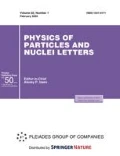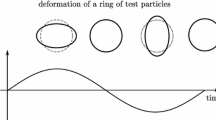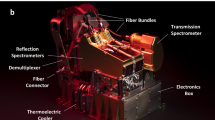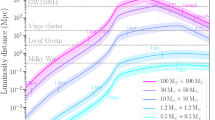Abstract
The conceptual new design of the Precision Laser Inclinometer (PLI) is proposed and developed what resulted in creation of compact instrument for its possible use in a restricted vacuum volume of sensitive elements of Gravitational Wave Interferometric Antennas. It is shown that the use of a position sensitive method—the dividing plates method—for the detection of angular inclination of laser beams, allows to reduce the dimensions of the PLI to a cube of 11 × 11 × 15 cm3 or to a cylinder with a diameter of 15 cm and a height of 11 cm. The reduction of the dimensions results in a simultaneous increase of 1.9 times in the sensitivity of recording the angular inclinations of the earth’s surface.

















Similar content being viewed by others
REFERENCES
R. Cessaro, “Sources of primary and secondary microseisms,” Bull. Seismol. Soc. Am. 84, 142–148 (1994).
F. Raab and D. Coyne, “Effect of microseismic noise on a LIGO interferometer,” LIGO-T960187-01-D 2/20/97.
M. Landès, F. Hubans, N. Shapiro, A. Paul, and M. Campillo, “Origin of deep ocean microseisms by using teleseismic body waves,” J. Geophys. Res. 115, b05302 (2010).
V. Ryabov, A. M. Correig, M. Urquizu, and A. Zaikin, “Microseism oscillations: From deterministic to noise-driven models,” Chaos Solitons Fractals 16, 195–210 (2003).
M. Obrebski, F. Ardhuin, E. Stutzmann, and M. Schimmel, “Detection of microseismic compressional (P) body waves aided by numerical modeling of oceanic noise sources,” J. Geophys. Res.: Solid Earth 118, 50233 (2013).
L. Naticchioni, M. Perciballi, F. Ricci, E. Coccia, V. Malvezzi, F. Acernese, F. Barone, G. Giordano, R. Romano, M. Punturo, R. de Rosa, P. Calia, and G. Loddo, “Microseismic studies of an underground site for a new interferometric gravitational wave detector,” Class. Quantum Grav. 31, 105016 (2014).
B. di Girolamo, J.-Ch. Gayde, D. Mergelkuhl, M. Schaumann, J. Wenninger, N. Azaryan, J. Budagov, V. Glagolev, M. Lyablin, G. Shirkov, and G. Trubnikov, “The monitoring of the effects of Earth surface inclination with the precision laser inclinometer for high luminosity colliders,” in Proceedings of RuPAC'2016, St. Petersburg, Russia.
N. Azaryan, V. Batusov, J. Budagov, V. Glagolev, M. Lyablin, G. Trubnikov, G. Shirkov, J.-Ch. Gayde, B. di Girolamo, A. Herty, H. Mainaud Durand, D. Mergelkuhl, and V. Rude, “Comparative analysis of earthquakes data recorded by the innovative Precision Laser Inclinometer instruments and the classic Hydrostatic Level System,” Phys. Part. Nucl. Lett. 14, 480–492 (2017).
N. Azaryan, J. Budagov, V. Glagolev, M. Lyablin, A. Pluzhnikov, A. Seletsky, G. Trubnikov, B. Di Girolamo, J.-Ch. Gayde, and D. Mergelkuhl, “Professional precision laser inclinometer: The noises origin and signal processing,” Phys. Part. Nucl. Lett. 16, 264–276 (2019).
B. P. Abbott et al., “Observation of gravitational waves from a binary black hole merger,” Phys. Rev. Lett. 116, 061102 (2016)
N. A. Robertson, C. A. Cantley, and N. Lockerbie, “LIGO Seismic isolation and suspension systems for advanced LIGO,” SPIE Proc. 5500, 81–91 (2004).
N. A. Robertson et al., “Quadruple suspension design for advanced LIGO class,” Quantum Grav. 19, 4043–4058 (2002).
Instrument Science White Paper LIGO-T1600119-v4 (2016).
N. Azaryan, J. Budagov, M. Lyablin, A. Pluzhnikov, B. di Girolamo, J.-Ch. Gayde, and D. Mergelkuhl, “Position-sensitive photoreceivers: Sensitivity and detectable range of displacements of a focused single-mode laser beam,” Phys. Part. Nucl. Lett. 16, 354–376 (2019).
https://www.hamamatsu.com/resources/pdf/ssd/s5980_ etc_kpin1012e.pdf.
A. E. Siegman, Lasers (Oxford Univ. Press, Mill Valley, CA, 1986).
P. E. Rutten, “High speed two-dimensional optical beam position detector,” Rev. Sci. Instrum. 82, 073705-1–073705-7 (2011).
J. D. Spear and R. E. Russo, “Low noise position sensitive detector for optical probe beam deflection measurements,” Rev. Sci. Instrum. 67 (7) (1996)
G. A. Michelet and J. P. Trenton, “Disposif de positionnement automatique d’un faisceau laser,” French Patent No. 2616555–A1 (1987)
N. Azaryan, J. Budagov, M. Lyablin, A. Pluzhnikov, B. di Girolamo, J.-Ch. Gayde, and D. Mergelkuhl, “Position-sensitive photoreceivers: Sensitivity and detectable range of displacements of a focused single-mode laser beam,” Phys. Part. Nucl. Lett. 16, 354–376 (2019).
A. Chandrakanta and A. Devassy, “The non-uniform characteristics of a photodiode,” Int. Adv. Res. J. Sci. Eng. Technol. 4 (Spec. Iss. 1), 25 (2018).
J. Campos, A. Corr, and A. Pons, “Response uniformity of silicon photodiodes,” Appl. Opt. 27 (24) (1988).
C. Clanet and D. Quere, “Onset of menisci,” Fluid Mech. 460, 131–149 (2002).
A. W. Adamson, Physical Chemistry of Surfaces, 5th ed. (Wiley, New York, 1990)
https://www.thorlabs.com/thorproduct.cfm?partnumber=POLARIS-K05#ad-image-0.
https://www.thorlabs.com/thorproduct.cfm?partnumber=POLARIS-P20.
ACKNOWLEDGMENTS
The authors are deeply grateful to V. Bednyakov, V. Glagolev, G. Trubnikov, O. Bruning, L. Rossi, J.‑Ch. Gayde and D. Mergelkuhl for their everlasting support and valuable discussions.
Author information
Authors and Affiliations
Corresponding author
Appendices
APPENDIX A
Figure 1 shows the displacement α of the laser beam on the dividing plate. One can determine the difference between the signals from the photodetectors Ph1 and Ph2 taking into account the reflection from the glass plate and the metal layer.
For the calculation, we introduce the following notation:
Rm—the coefficient of reflection from the metallic surface;
Rg—the coefficient of reflection from the glass surface;
Tg—the coefficient of transmission by the flat-parallel glass plate.
Considering that the optical plate has two reflective surfaces it can be shown that Rg and Tg are:
where R is the coefficient of reflection from one surface of a dividing glass plate.
One can determine the power of the laser beam, which arrives on the photodetectors Ph1, Ph2:
Thus, the power difference arriving on the photodetectors Ph1 and Ph2 is
With a symmetric arrangement of the laser beam relative to the dividing line of the dividing plate (α = 0 and consequently \({{P}_{\alpha }} = 0\)), the difference in power of the laser beams falling on the photoreceivers Ph1, Ph2 will be
Taking into account the proportional dependence of the signal U on laser power P, we determine the difference signals \(\Delta U\) and \(\Delta {{U}_{{\alpha }}}\) from the photoreceivers Ph1 and Ph2.
Thus, the difference signal and \(\Delta {{U}_{{\alpha }}}\) from the photoreceivers Ph1 and Ph2, corresponding to the offset α of the laser beam from the symmetric position of the laser beam relative to the dividing line, will be
As can be seen from the expression (A.4) \(\Delta {{U}_{{\alpha }}}\) is proportional to the relative power \(~\frac{{{{P}_{{\alpha }}}}}{P}\) of the laser radiation in gap corresponding to the displacement α.
When using
(a) the metallic reflecting layer of Al (\({{R}_{m}} = 0.85\));
(b) glass with index of refraction n = 1.5;
(c) polarized laser irradiation of λ = 0.65 μm;
(d) plate inclination angle of 45° (\(2{{R}_{g}} = 0.05\))
one gets finally \(K = \left( {1 + {{R}_{m}} - 2{{R}_{g}}} \right) = \)1.8.
APPENDIX B
To find the displacement signal \(\frac{{\Delta {{U}_{{\alpha }}}}}{U}\) one is to determine the \(\frac{{{{P}_{\alpha }}}}{P}\) ratio in function of the displacement α.
Figure 19 shows a single-mode laser beam spot, separated into two parts by a dividing plate.
We need to determine the power difference between the laser beams incident on the photoreceivers Ph1 and Ph2 (Fig. 18). The power of the laser beam P1, transmitted by the plate and the reflected power P2, are shown in Fig. 19.
Define the expression P1 and P2 for a single-mode laser beam
where r0 is radius of the laser beam and w = 300 μm is—as accepted by us—the upper value of possible α displacement.
Thus, the final expression for the photoreceivers Ph1 and Ph2 difference signal from in the method of dividing plates has the form
Rights and permissions
About this article
Cite this article
Budagov, J., Di Girolamo, B. & Lyablin, M. The Compact Nanoradian Precision Laser Inclinometer—an Innovative Instrument for the Angular Microseismic Isolation of the Interferometric Gravitational Antennas. Phys. Part. Nuclei Lett. 17, 916–930 (2020). https://doi.org/10.1134/S154747712007002X
Received:
Revised:
Accepted:
Published:
Issue Date:
DOI: https://doi.org/10.1134/S154747712007002X






